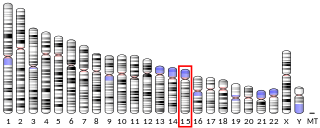Related Research Articles

Cellulase is any of several enzymes produced chiefly by fungi, bacteria, and protozoans that catalyze cellulolysis, the decomposition of cellulose and of some related polysaccharides:

Beta-secretase 2 is an enzyme that cleaves Glu-Val-Asn-Leu!Asp-Ala-Glu-Phe in the Swedish variant of Alzheimer's amyloid precursor protein. BACE2 is a close homolog of BACE1.

Caveolin-1 is a protein that in humans is encoded by the CAV1 gene.

Protein kinase C beta type is an enzyme that in humans is encoded by the PRKCB gene.

In enzymology, a peptide-N4-(N-acetyl-beta-glucosaminyl)asparagine amidase (EC 3.5.1.52) is an enzyme that catalyzes a chemical reaction that cleaves a N4-(acetyl-beta-D-glucosaminyl)asparagine residue in which the glucosamine residue may be further glycosylated, to yield a (substituted) N-acetyl-beta-D-glucosaminylamine and a peptide containing an aspartate residue. This enzyme belongs to the family of hydrolases, specifically those acting on carbon-nitrogen bonds other than peptide bonds in linear amides.

Ubiquitin-conjugating enzyme E2 D2 is a protein that in humans is encoded by the UBE2D2 gene.

Alpha-(1,3)-fucosyltransferase is an enzyme that in humans is encoded by the FUT7 gene.

Ubiquitin-conjugating enzyme E2 D3 is a protein that in humans is encoded by the UBE2D3 gene.

3-beta-glucuronosyltransferase 1 (B3GAT1) is an enzyme that in humans is encoded by the B3GAT1 gene, whose enzymatic activity creates the CD57 epitope on other cell surface proteins. In immunology, the CD57 antigen is also known as HNK1 or LEU7. It is expressed as a carbohydrate epitope that contains a sulfoglucuronyl residue in several adhesion molecules of the nervous system.

Isocitrate dehydrogenase [NAD] subunit alpha, mitochondrial (IDH3α) is an enzyme that in humans is encoded by the IDH3A gene.

Beta-1,4-galactosyltransferase 7 also known as galactosyltransferase I is an enzyme that in humans is encoded by the B4GALT7 gene. Galactosyltransferase I catalyzes the synthesis of the glycosaminoglycan-protein linkage in proteoglycans. Proteoglycans in turn are structural components of the extracellular matrix that is found between cells in connective tissues.

Xylosyltransferase 2 is an enzyme that in humans is encoded by the XYLT2 gene.

In molecular biology, a carbohydrate-binding module (CBM) is a protein domain found in carbohydrate-active enzymes. The majority of these domains have carbohydrate-binding activity. Some of these domains are found on cellulosomal scaffoldin proteins. CBMs were previously known as cellulose-binding domains. CBMs are classified into numerous families, based on amino acid sequence similarity. There are currently 64 families of CBM in the CAZy database.
Alpha-1,6-mannosyl-glycoprotein 4-beta-N-acetylglucosaminyltransferase is an enzyme with systematic name UDP-N-acetyl-D-glucosamine:2,6-bis(N-acetyl-beta-D-glucosaminyl)-alpha-D-mannosyl-glycoprotein 4-beta-N-acetyl-D-glucosaminyltransferase. This enzyme catalyses the following chemical reaction
N,N'-diacetylchitobiose phosphorylase is an enzyme with the systematic name N,N'-diacetylchitobiose:phosphate N-acetyl-D-glucosaminyltransferase. This enzyme was found in the genus Vibrio initially but has now been found to be taken up by Escherichia coli as well as many other bacteria. One study shows that Escherichia coli can replicate on a medium that is just composed of GlcNAc a product of phosphorylation of N,N'-diacetylchitobiose as the sole source of carbon. Because E. coli can go on this medium, the enzyme is present. The enzyme has also been found in multiple eukaryotic cells as well, especially in eukaryotes that make chitin and break chitin down. It is believed that N,N'-diacetylchitobiose phosphorylase is an integral part of the phosphoenolpyruvate:glucose phosphotransferase system (PTS). It is assumed that it is involved with Enzyme Complex II of the PTS and is involved with the synthesis of chitin. The enzyme is specific for N,N'-diacetylchitobiose.
Endo-α-N-acetylgalactosaminidase (EC 3.2.1.97, endo-α-acetylgalactosaminidase, endo-α-N-acetyl-D-galactosaminidase, mucinaminylserine mucinaminidase, D-galactosyl-3-(N-acetyl-α-D-galactosaminyl)-L-serine mucinaminohydrolase, endo-α-GalNAc-ase, D-galactosyl-N-acetyl-α-D-galactosamine D-galactosyl-N-acetyl-galactosaminohydrolase) is an enzyme with systematic name glycopeptide-D-galactosyl-N-acetyl-α-D-galactosamine D-galactosyl-N-acetyl-galactosaminohydrolase. This enzyme catalyses the following chemical reaction
Exo-1,4-beta-D-glucosaminidase is an enzyme with systematic name chitosan exo-(1->4)-beta-D-glucosaminidase.! This enzyme catalyses the following chemical reaction
Alpha-D-xyloside xylohydrolase is an enzyme. This enzyme catalyses the following chemical reaction
Gellan tetrasaccharide unsaturated glucuronyl hydrolase (EC 3.2.1.179, UGL, unsaturated glucuronyl hydrolase) is an enzyme with systematic name beta-D-4-deoxy-Delta4-GlcAp-(1->4)-beta-D-Glcp-(1->4)-alpha-L-Rhap-(1->3)-beta-D-Glcp beta-D-4-deoxy-Delta4-GlcAp hydrolase. This enzyme catalyses the following chemical reaction
Rhamnogalacturonan exolyase is an enzyme with systematic name α-L-rhamnopyranosyl-(1→4)-α-D-galactopyranosyluronate exolyase. This enzyme catalyses the following chemical reaction
References
- ↑ Honda Y, Kitaoka M (December 2004). "A family 8 glycoside hydrolase from Bacillus halodurans C-125 (BH2105) is a reducing end xylose-releasing exo-oligoxylanase". The Journal of Biological Chemistry. 279 (53): 55097–103. doi: 10.1074/jbc.m409832200 . PMID 15491996.
- ↑ Fushinobu S, Hidaka M, Honda Y, Wakagi T, Shoun H, Kitaoka M (April 2005). "Structural basis for the specificity of the reducing end xylose-releasing exo-oligoxylanase from Bacillus halodurans C-125". The Journal of Biological Chemistry. 280 (17): 17180–6. doi:10.1074/jbc.m413693200. PMID 15718242.